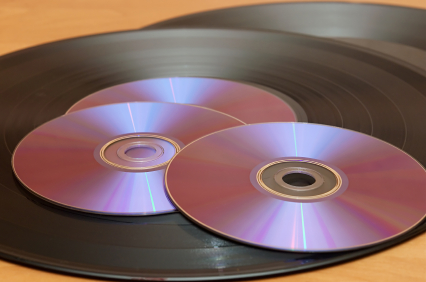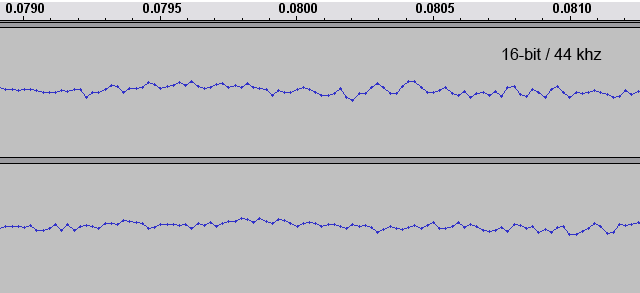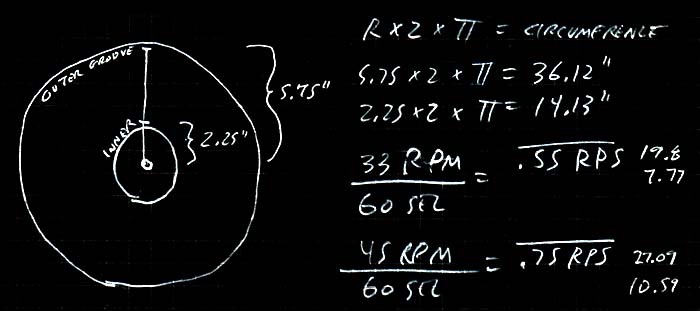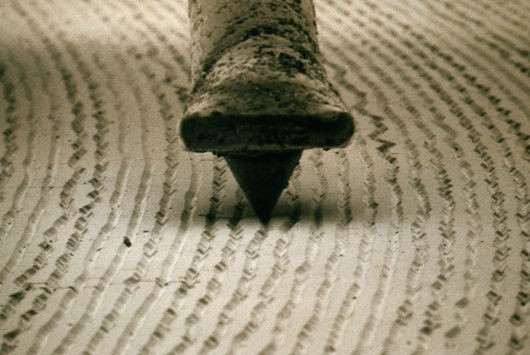
I've heard the vinyl purists who claim that vinyl records have better audio reproduction than Compact Discs. They rant and rave about bit's and show choppy wave forms with smooth 'analog' overlays depicting the sheer obviousness of the 'better' audio signal. Bullshit! The top Calvin and Hobbes cartoon is your first hint at the real dilemma with vinyl records.
Vinyl has a Steadily Decreasing Sample Rate
 Since the record plays at a steady speed, the audio fidelity (sample rate) starts to decrease from the very beginning! This is why albums tend to pack the 'hit' songs into the first 2 tracks of a side, in order to get the best clarity.
Since the record plays at a steady speed, the audio fidelity (sample rate) starts to decrease from the very beginning! This is why albums tend to pack the 'hit' songs into the first 2 tracks of a side, in order to get the best clarity.
This is equivalent to the Sample Rate on a Compact Disc. A Compact Disc's Sample Rate never changes, mostly due to the red book audio standard, and all audio files encoded onto a CD are expected to have 44100 samples per second (44.1kHz). Therefore, there is no compression, and a CD will hold a maximum of 79.8 minutes; the audio can be silence or punk music, and the CD spec doesn't care.

Example of a 16-bit 44kHz Stereo Audio File as seen in an Audio Editor - each Dot on the line is a Sample Point.
Doing the Sample Rate Math...
I used basic high-school geometry. I measured a typical 12" vinyl record's grooves from the center of the record. The 'start' groove, on the outside of the record measured 5.75" from the center. The 'end' groove measured at around 2.25" from center. Calculating for circumference, then rotation speed, I came up with the final inches per second the needle covers at the beginning and end of the record, assuming a steady 33 revolutions per minute (rpm), or 45 rpm.

As you can see in the lower right hand corner of the above graphic, a 33rpm record spins at 19.8 inches per second at the outside of the record, then gradually slows to a meager 7.7 inches per second. Less than half the sample rate.
Even at 45 rpm, the starting speed is the best resolution available, at a speedy 27.09 inches per second, slowing to 10.59 inches per second in the center. Note that a 45rpm record would actually be producing a higher fidelity signal compared to a 33rpm, since it's moving 136% faster at the outermost point. This also demonstrates the wider audio response available to vinyl spinning at 45rpm: much more bass.
Assuming that a vinyl record has the equivalent sample rate of a CD at it's outermost point (ignoring rotational speed), we can extrapolate it's sample rate at it's innermost point as well. 33rpm records sample rate decreases to 17150 samples per second (17.1kHz), whereas 45rpm records sample rates decrease to 17240 samples per second (17.2kHz). Maybe (not) surprisingly, both speeds end with a nearly equivalent sample rate.
Below, a picture of the two sample rates side by side (in a single microsecond) to demonstrate the loss of detail:

Vinyl has a Tiny Sample Depth, too!
There is but a single spiral groove on each side of the record. Each groove cannot touch or get too close to it's neighboring groove, otherwise the record will be unplayable. If you imagine a wobbly line as the groove, let this simple page of animated files show how the stereo signal is embedded into the groove of a record! This shows that the groove, in essence, stays steady in the middle of the needle, which has a maximum tip radius of .001 inches. Since the record groove is packed to achieve a 24-minute maximum playtime per side, the sample size (read: groove width) is also lowered, offering less volume of the audio stream.
Luckily, I ran across this fantastic Electron Microscope photo of the cross-cut detail of a vinyl record, taken just earlier this year in February 2012 (source unknown).

830x Close Up of 3 Grooves in a Typical Vinyl Record
Thankfully, in the full version of the photo, they included a helpful legend for scale. Now we can take some accurate measurements, and extrapolate the physical distance a needle moves on a vinyl record.
I've superimposed the legend on top of the art to deduce that the grooves in this record are between 120-160 Micrometres apart (a micrometre is a millionth of a meter, a thousandth of a millimeter). This is .12 millimeters, so we can expect to get 4-6 or so grooves per millimeter on a record. The grooves are also around 80 micrometers wide. This gives them a decent amount of headroom (i.e. distance between each groove so they can play lounder), but it's not much.


I can also deduce the approximate separation (and maximum output) of stereo signals using this same method, and the depth of the groove in this particular image. We can also see the depth of the groove is between 35-40 Micrometres, and the difference in loudest and silence in around 25 Micrometres.

Therefore, we can guess that the record needle moves a maximum of a few dozen micrometres up and down in either 45 degree axis in order to create an audio wave. This slight tremor is amplified by the needle pickup, the turntable, and sometimes again by a RIAA pre-amplifier in order to deliver you this audio stream. Each amplification also reduces perceptual bit depth, although since this is an analog wave, it's decay is measurable.
25-40 Micrometres vs. 65,536 digital values
Which has more nuance and detail? A wiggling groove moving a mere 25-40 thousands of a millimeter, or 65,536 different values available on a 16-bit CD recording?

Laundry List of other Vinyl Shortcomings
- Records are large and heavy, making transporting them logistically difficult.
- Mold can grow on vinyl and may permamently damage it and its sleeve, and can spread from record to record.
- Surface noise, while often inaudible, will always be present and measurable, even on a brand new LP.
- Certain parameters of vinyl recording and playback were never formally standardized, and vary considerably between records. Distortion from these effects is generally considered extremely audible and very difficult (if not impossible) to correct.
- Any play of a record, even one, has the risk of permanently damaging the record. Repeated playback with an excessively worn or misaligned cartridge will cause permanent damage.
- Cartridge stylii wear out over time (typically 200-1000 hours) and require periodic replacement.
Further Reading and Resources:
I always like to start at the ever-comprehensive Wikipedia article on the LP Record, but also check out this Audio Engineers advice in Mastering for Vinyl and the typical shortcomings of Vinyl playback.
Convert your Records to Compact Discs
Use my Vinyl to CD Conversion service - You'll love the professional results! Returned in a more convenient Compact Disc format, along with free MP3 versions for your media player! No record player needed!